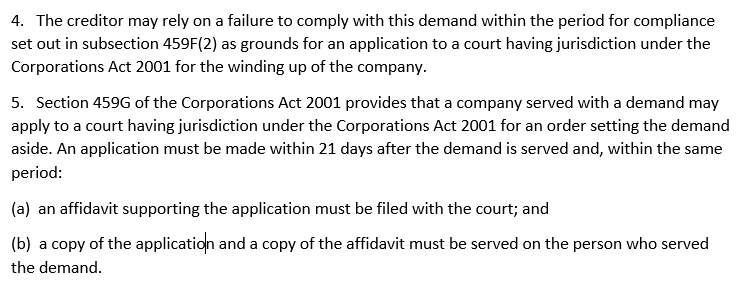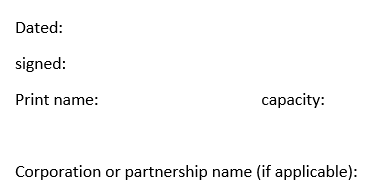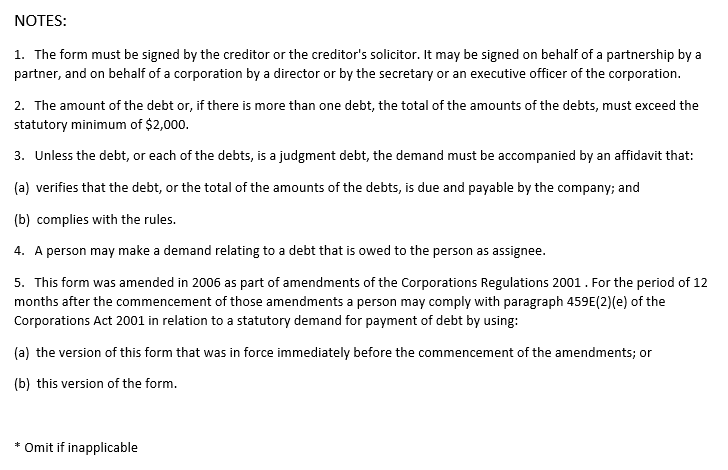Table of Contents
Toggle
How to Draft a Statutory Demand – Form 509H
Do you need to know how to draft a statutory demand – Form 509H?
A statutory demand is a demand for payment pursuant to section 459E of the Corporations Act 2001 (Cth) (“the Corporations Act”).
If you are a creditor of a debtor company, and the company is unable to pay its debts when they become due and payable, then you can serve the company with a creditor’s statutory demand for payment, provided that the debt (or debts) are equal to or more than the statutory minimum of $4,000.00.
If the debtor company does not do one or more of the following, then they are presumed to be insolvent, and a creditor can take steps to wind in up in insolvency:
- Pay the amount of the debt; or
- Secure or compound for the debt; or
- Request that the issuer withdraw the demand; or
- Apply to the Federal Court to set the demand aside.
This article will explain how to draft a statutory demand – Form 509H.
PLEASE NOTE – This article is for general information only. It is not legal advice. We always recommend that you seek qualified legal advice from a lawyer.
Creditor’s Statutory Demand for Payment of Debt
The form of the statutory demand is Form 509H which is found at Schedule 2 of the Corporations Regulations 2001 (Cth). I have also extracted it and annexed Form 509H to the bottom of this article. Please scroll to the end.
We will attempt to guide you through the process of drafting the demand and how to draft a statutory demand – Form 509H.
Name, ACN, and Address
If you intend to draft a statutory demand – form 509H, firstly you need to correctly Identify the debtor company.

When thinking about how to draft a statutory demand – Form 509H, the name and the ACN (Australian Company Number) of the debtor company must be correct, and must be able to correctly identify the debtor company.
The name and the ACN can be found by conducting a search of the database of the Australian Securities and Investments Commission (“ASIC”) website.
The address of the registered office of the company must also be correctly identified. A company’s registered office may not be its principal place of business. It may also be an accountant’s office, for example. There is a section of the current extract which identifies the registered office.
Tip – You are going to have to obtain a current extract for the debtor company from ASIC in order to correctly serve the demand, so we suggest doing this now, and simply the copy (ctrl + c) and paste (ctrl + v) this information directly from the current extract, into the statutory demand. This eliminates any possibility of user error.
Section 9 of the Corporations Act defines one of the ways a defect in the demand can exist to be a misdescription of a person or entity. It is vital that you get this part correct, the Courts have said that “it is not asking too much” that a creditor correctly identify the debtor.
Your Name, Address and the Debt
Next, when learning how to draft a statutory demand – Form 509H, you must correctly identify your own name, address, and the amount of the debt.

A creditor in this section must clearly identify the entity to which the debt is owed.
If the debt is owed to a person, then correctly identify the person. If the debt is owed to a company, then correctly identify the details of the Company.
This may sound like being over-cautious but the demand should clearly identify the correct entity of the creditor.
For example, if the debt relates to an unpaid invoice for “The Company 1 Pty Ltd ACN 123 456 789” then it important that this company is identified as the creditor, not the director personally, or a subsidiary company, or other entity.
The Amount of the Debt
When you draft a statutory demand – form 509H, you must then clearly identify the amount of the debt.

Where you see an asterisk in the Form 509H then you are to keep one and delete the other. The statutory demand form actually says “* Omit if inapplicable”.
The debt amount can relate to one debt, or a number of debts.
If your demand relates to one debt, keep the first and delete the second. If your debt relates to a number of debts, then delete the first and keep the second.
The amount that you insert here, bust be identical to the amount that you put into the schedule.
Please refer to the section below regarding the Schedule.
Section 9 of the Corporations Act defines other ways a defect in the demand can exist to be a misstatement of an amount or total; and a misdescription of a debt or other matter. It is vital that you also get this part correct, failure to correctly identify the creditor or the correct amount of the debt may allow the demand to be set aside, and you may have to pay costs for the application.
Amount is Due and Payable by the Company
Once that you have correctly identified the parties, and the amount of the debt, the demand must clearly state that the debt is due and payable by the debtor company.

If you are serving the statutory demand with an affidavit in support, then delete the first option and keep the second option.
The deponent is the person who has sworn or affirmed the affidavit. This is usually the director of the creditor (if the creditor is a company) or the creditor (if a natural person).
The date of the affidavit and the date of the statutory demand must be the same.
You must state that the total amount of the debt or debts is due and payable by the debtor company.
What you Require the Debtor to do
The next section of the statutory demand let’s the debtor company know what they are required to do to comply with the statutory demand.

If you chose one (1) debt in paragraph 1, then choose one (1) debt here. Is you chose a number of debts in paragraph 1, then choose a number of debts here too.
Then, leave the rest. The debtor is required to pay the debt, secure or compound for the debt to the creditor’s reasonable satisfaction. Section 3, 3(a), and 3(b) must be left in the statutory demand.
Paragraphs 4 and 5 of the Demand
Paragraphs 4 and 5 of the statutory demand are to be left exactly as they are.

Paragraph 4 lets the debtor company know that if they do not comply with paragraph 3, then the creditor can apply to wind the company up.
Paragraph 5 lets the debtor company know they can apply to set the demand aside (if they have grounds). It also lets the company know that a sealed copy of the application and affidavit in support must be served on the creditor within 21 days of being served with the statutory demand.
The Warning Box
Next is the warning box, warning the debtor company of the consequences of failing to respond to the statutory demand.

The warning box must be left in.
Although the Courts have ruled that omission of the warning box is a defect which does not cause substantial injustice, it should simply be left in.
Address for Service of Application
Next is the address for service for copies of an application to set aside the demand and the supporting affidavits.

The address for service of the creditor must be in the same State as the registered office of the debtor company. So, for example if the registered office of the debtor is in VIC from a debt which arose in QLD, the address for service must be in VIC.
Although the Courts have ruled that an address for service in another State is a defect which may not cause substantial injustice, you should attempt to get an address for service in the state where the debtor company has their registered office.
Tip – When thinking about how to draft a statutory demand, you can engage a solicitor in that state to act as your “Town Agent” if you do not live in that state. This law firm will charge a reasonable fee to accept service of the documents and provide them to you. Google “town agent” and the State you need to have an address for service.
Debt Schedule
This is arguably the most important section of the statutory demand.

This section must clearly and accurately identify the debt, and the amount of the debt.
Judgment Debt
If the debt is a judgment debt, then clearly identify the judgment debt. Add the name of the Court, the date of the order, the Court proceeding number, and anything else that you need to correctly identify the judgment debt. Annex a copy of the judgment or money order to the statutory demand.
If the debt is a decision in the Queensland Civil and Administrative Tribunal (“QCAT”) registered in the Magistrates Court, then clearly identify the particulars of the QCAT decision to which the enforceable money order relates, along with the particulars of the registered Form 1.
Non-Judgment Debt
When thinking about how to draft a statutory demand, if the debt is not a judgment debt, you must clearly and precisely particularise the debt so that the debtor company can sufficiently identify the debt.
For example, if the debt relates to an unpaid invoice, then clearly and precisely articulate the details of the invoice. Invoice number, date, amount, and particulars of the goods and/or services to which the invoice relates. For example, the Description of the debt could be something like:
The non-payment of invoice number WGH664589 dated 21 October 20XX in the amount of $36,406.84 for work conducted between the dates of 27 June 20XX and 4 July 20XX at the property located at 15 Queen Street, Noosa, Qld 4573.
If you have a number of unpaid invoices, then particularise each one as above.
Then add the total amount of the unpaid invoice (or invoices) under the Amount of the debt.
Then add the total amount of the debts under Total Amount.
Annex the invoices to the affidavit in support of the statutory demand.
Tip – Put the debt schedule into a table. Two columns, one headed Description of the debt and the other headed Amount of the debt. Add another row for each debt. Total in the bottom corner. This makes the demand clear and easy to understand.
Section 9 of the Corporations Act defines other ways a defect in the demand can exist to be a misstatement of an amount or total; and a misdescription of a debt or other matter. It is vital that you also get this part correct, failure to correctly identify the debt or the amount of the debt may allow the demand to be set aside, and you may have to pay costs for the application.
Date, Signature and Capacity
Finally, when thinking about how to draft a statutory demand, you need to date, and sign the statutory demand.

The date of the statutory demand must be the same date as the date of swearing or affirming the affidavit in support.
The statutory demand must be signed on behalf of the creditor. If the creditor is a natural person, then the person named in the demand. If the creditor is a company then signed by a person with capacity to sign on behalf of the company (best case – the director of the company, but can be secretary or an executive officer such as a CFO).
The statutory demand can also be signed by the solicitor acting on behalf of the company.
If signed on behalf of a partnership, or on behalf of a corporation, then you must include the name of the partnership or the corporation.
The person signing must also print their name, and put their capacity.
The capacity may be “creditor” or “director of the creditor” or “solicitor for the creditor” for example.
The Notes
Lastly, when thinking about how to draft a statutory demand, the notes included in the statutory demand.

The notes must be left in.
Although the Courts have ruled that omission of the notes are a defect that does not cause substantial injustice, you should just keep then included in the demand.
How to Draft a Statutory Demand
Hopefully, this article helped to with how to draft a statutory demand.
We strongly recommend getting a statutory demand solicitor to draft the demand for you.
How to Draft a Statutory Demand – FAQ & Answers
Welcome to our FAQ section where we address common questions about how to draft a statutory demand under the Corporations Act 2001.
Here you’ll find detailed explanations to help you understand the process and requirements for issuing a statutory demand in Australia.
What is a statutory demand under Form 509H?
A statutory demand under Form 509H is a legal tool used by creditors to demand payment of a debt from a debtor company under section 459E of the Corporations Act 2001. This form is used when a debtor company owes a creditor an amount equal to or exceeding $4,000 and is presumed to be insolvent if it fails to respond adequately within 21 days. The form must specify the amount of debt, offer the debtor company the opportunity to pay, secure, or compound for the debt, and provide clear instructions on how the debtor company can contest the demand.
How do I correctly identify the debtor company in Form 509H?
Correctly identifying the debtor company involves specifying the legal name and Australian Company Number (ACN) as registered with the Australian Securities and Investments Commission (ASIC). It’s crucial to use the current registered office address from ASIC records. Any inaccuracies in identifying the debtor company can be grounds for having the statutory demand set aside, hence the importance of using the most recent ASIC extract for accurate details.
Draft a Statutory Demand – What details are required?
When working out how to draft a statutory demand, the creditor must clearly state their name and address in the statutory demand. If the creditor is a company, include the company’s name and ACN. This ensures that the demand is formally correct and legally enforceable. Precise identification avoids disputes regarding the legitimacy of the demand and prevents potential grounds for dismissal due to technical errors.
How should the debt be described in Form 509H?
The debt must be described precisely with details that allow the debtor to clearly understand what is owed. This includes the amount of the debt, relevant dates, and specific details about how the debt was incurred, such as invoice numbers and service descriptions. Ambiguity in the debt description can lead to disputes or grounds for the demand to be set aside.
What is the significance of the affidavit that accompanies the statutory demand?
The affidavit serves to verify that the debt is due and payable. It should be made by a person who can attest to the facts of the debt, usually the creditor or their agent. The affidavit must be dated, signed, and align precisely with the information in the statutory demand. This is crucial for establishing the creditor’s claim as valid and enforceable.
What actions must the debtor company take upon receiving a statutory demand?
Upon receiving the statutory demand, the debtor company has 21 days to either pay the debt, secure the debt to the satisfaction of the creditor, or make an arrangement for settling the debt. Failing these, the company can also challenge the demand by applying to the court to set it aside on the grounds of defects in the demand or disputes over the claimed debt.
What happens if the debtor company does not respond to the statutory demand?
If the debtor company fails to respond to the statutory demand within 21 days, it is presumed to be insolvent. This presumption allows the creditor to initiate court proceedings to wind up the company. The failure to respond indicates the company’s inability to pay its debts, justifying insolvency proceedings.
Can a statutory demand be set aside?
Yes, a statutory demand can be set aside if the debtor company successfully challenges it in court. Grounds for setting aside the demand include substantial defects in the form or content of the demand, misstated debt amounts, or an existing dispute over the claimed debt. The company must file an application to set aside the demand within 21 days of its receipt.
What are the risks for creditors in issuing a statutory demand?
If a statutory demand is set aside, the creditor may be ordered to pay the legal costs of the debtor company. Errors in drafting or serving the demand can lead to it being contested and set aside, thus it is recommended that creditors seek legal advice before issuing a statutory demand.
How important is the warning box in the statutory demand?
The warning box is a critical component of the statutory demand, detailing the consequences of not responding to the demand. Its presence helps ensure that the debtor is fully aware of the implications of insolvency proceedings should they fail to comply with the demand.
What should be included in the address for service of application?
The address for service should be in the same state as the registered office of the debtor company. This address will be used for any legal correspondence related to the statutory demand, including the service of documents for court proceedings if the demand is contested.
How is the debt schedule in a statutory demand formatted?
The debt schedule should clearly list each individual debt, its description, and the amount owed. If multiple debts are included, each should be itemized with sufficient detail to enable the debtor to understand and verify each claim.








